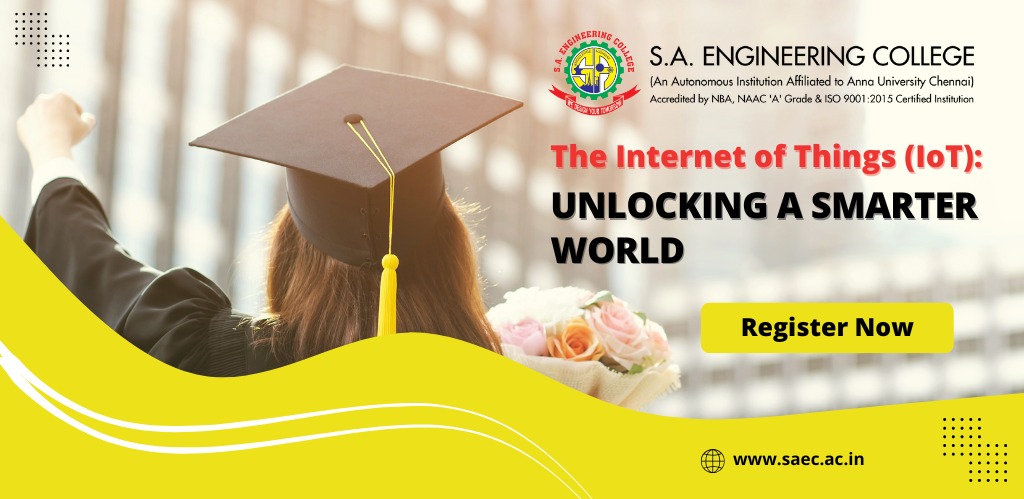
The Internet of Things (IoT): Unlocking a Smarter World
- Posted by S.A.E.C
- Categories IoT, Uncategorized
- Date December 15, 2024
In an era where connectivity has become second nature, the Internet of Things (IoT) stands as a technological marvel transforming the way we interact with devices, systems, and environments. IoT represents a network of interconnected devices embedded with sensors, software, and other technologies that exchange data seamlessly over the internet. From smart homes and healthcare to industrial automation and environmental monitoring, IoT has revolutionized various domains. Let’s delve into what IoT entails, its applications, challenges, and future potential.
What is the Internet of Things?
At its core, IoT is a system where physical devices—ranging from household gadgets to industrial machines—are connected to the internet, enabling them to communicate and share data. These devices are equipped with sensors that gather information, processors to analyze it, and connectivity modules to transmit the data to a centralized hub or cloud system.
Key Components of IoT:
- Devices and Sensors: Capture real-time data from the environment. Examples include temperature sensors, heart rate monitors, and GPS trackers.
- Connectivity: The backbone of IoT, allowing devices to connect via Wi-Fi, Bluetooth, or 5G networks.
- Data Processing: Cloud systems or local edge devices analyze the collected data to derive actionable insights.
- User Interface: Applications or dashboards where users monitor and control IoT devices.
IoT operates on the principle of automation and efficiency, reducing human intervention while optimizing processes across sectors.
Applications of IoT in Real Life
The versatility of IoT makes it a cornerstone of innovation. Here are a few sectors where IoT is making a significant impact:
- Smart Homes:
IoT-powered devices like smart thermostats, lighting systems, and security cameras enhance convenience and safety. For instance, you can remotely adjust your home’s temperature or receive alerts if unusual activity is detected.
- Healthcare:
IoT has brought a revolution in patient care through wearable devices, remote health monitoring, and smart medical equipment. Patients with chronic conditions can use IoT-based health trackers to share real-time data with their doctors.
- Industrial IoT (IoT):
Factories and industries use IoT for predictive maintenance, supply chain optimization, and energy efficiency. Connected machines reduce downtime and increase productivity by predicting failures in advance.
- Smart Cities:
IoT enables the development of intelligent urban infrastructure, including traffic management systems, waste disposal mechanisms, and energy-efficient street lighting.
- Education:
IoT enhances the learning experience with smart classrooms equipped with connected projectors, interactive boards, and virtual labs. Students can access educational resources tailored to their individual needs.
- Environmental Monitoring:
IoT devices play a crucial role in measuring air quality, monitoring water levels, and tracking wildlife movements, helping combat climate change and preserve ecosystems.
IoT and Engineering Education
For engineering students, IoT is more than just a buzzword; it represents a field of immense potential and growth. At S.A. Engineering College, integrating IoT concepts into the curriculum ensures students gain hands-on experience and industry-relevant skills.
Benefits of Learning IoT for Engineering Students:
- Skill Development: IoT training helps students master coding, data analytics, and hardware integration.
- Innovation Opportunities: Students can design IoT projects like automated irrigation systems or smart energy meters.
- Career Prospects: With IoT being a rapidly growing field, graduates can explore roles such as IoT Developer, Data Scientist, or Automation Engineer.
The college’s dedicated labs, IoT workshops, and expert faculty guide students to build prototypes and undertake real-world problem-solving.
Challenges in IoT Implementation
Despite its transformative potential, IoT faces several challenges:
- Data Privacy and Security:
As devices collect vast amounts of data, ensuring its security is critical. Vulnerable systems are prone to cyberattacks, jeopardizing sensitive information.
- Interoperability:
The lack of standardization across devices makes integration complex. Ensuring compatibility among devices from different manufacturers remains a challenge.
- Energy Consumption:
IoT devices, especially in remote locations, need efficient power sources to operate continuously.
- Scalability Issues:
As the number of connected devices grows, maintaining seamless connectivity and handling large datasets becomes increasingly demanding.
- Cost of Implementation:
The initial setup of IoT systems, including sensors and networks, can be expensive, especially for small businesses and developing nations.
The Future of IoT
IoT is not a fleeting trend; it is shaping the future. Here’s what lies ahead:
- 5G Integration:
With the rollout of 5G, IoT devices will achieve faster data transfer rates and lower latency, enabling advanced applications like autonomous vehicles and smart grids.
- Edge Computing:
To address latency issues and reduce dependency on centralized cloud systems, IoT will increasingly adopt edge computing, where data processing happens closer to the source.
- AI-Powered IoT:
Artificial intelligence will amplify IoT’s capabilities by enabling devices to make autonomous decisions, predict user needs, and offer personalized experiences.
- IoT in Agriculture:
IoT-driven precision farming, including soil sensors and automated irrigation systems, will revolutionize how we grow crops, ensuring sustainability.
- Sustainability:
Future IoT solutions will focus on energy efficiency, waste reduction, and promoting green technology to combat environmental challenges.
Conclusion: A Connected Tomorrow Awaits
The Internet of Things has become an integral part of our daily lives, offering unparalleled opportunities for innovation and efficiency. From smart homes to industrial automation, its applications are boundless, and its potential is still unfolding. For engineering students, understanding IoT is not just about keeping pace with technology—it’s about shaping the future.
S.A. Engineering College empowers its students with the knowledge and skills to explore IoT, equipping them for the challenges and opportunities in this dynamic field. By fostering creativity and technical expertise, the college ensures that its graduates are at the forefront of technological advancements.
Are you ready to dive into the fascinating world of IoT and be part of the next technological revolution? Join S.A. Engineering College, where innovation meets education.
Explore the future. Create the impossible. Build the smarter world of tomorrow with us!



